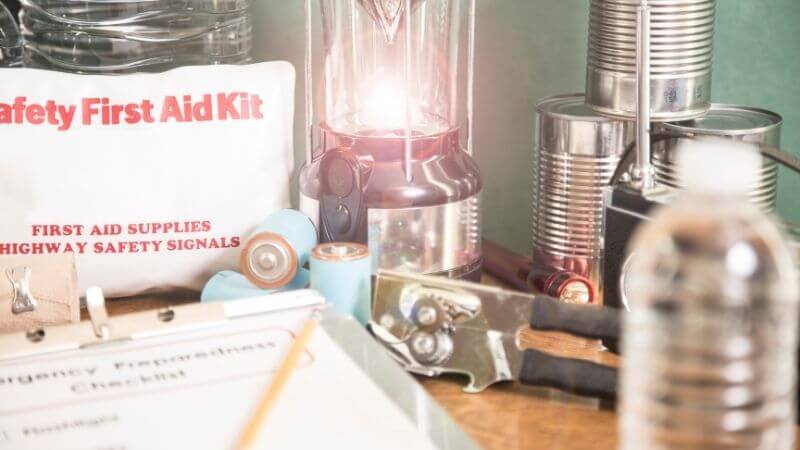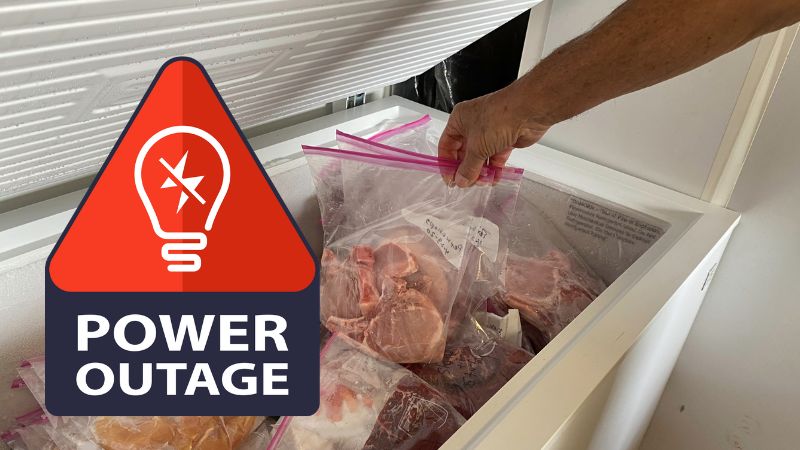The Best Fluffy Pancakes recipe you will fall in love with. Full of tips and tricks to help you make the best pancakes.

Wondering what foods to stock for a power outage? This emergency food list for power outage includes 25 non-perishable essentials that keep your family fed—no electricity needed.
In August 2020, an unusual summer storm knocked out power for weeks in Cedar Rapids, Iowa. My relatives and friends quickly learned how valuable a well-stocked pantry can be.
Creating an emergency food list for power outage was a lesson learned by many in Cedar Rapids, especially after the storm. Many people underestimated the value of an emergency food list for power outage until they experienced the chaos firsthand.
The rare derecho thunderstorm hit the town damaged almost every house and building in the city. The storm caused $7.5 billion in damage between South Dakota and Ohio, ranking it as the most costly thunderstorm in U.S. history.
I live 75 miles due north of the historic weather event, but that didn’t exclude me from it. People were raiding northern towns for generators, gas, and food. No one had time to prepare. In the land of tornadoes, this “thunderstorm” was never predicted to be as violent as it was. Hopefully, that won’t be a situation any of us find ourselves in.
Check out How to Keep Food Cold During a Power Outage: Smart Tips for Fridge & Freezer Safety and Using a Generator to Keep Food Safe During a Power Outage.
Table of Contents
- Why You Need an Emergency Food List
- 25 Best Foods for a Power Outage
- Best Emergency Liquids to Stock for Power Outages
- Special Food Needs During an Emergency
- Emergency Food Math: How Much Do You Need?
- Tips for Storing Emergency Food
- Emergency Food Bag is a Grab-and-Go Must
- Emergency Food FAQs
- In Conclusion: Your Emergency Food List for Power Outage
Why You Need an Emergency Food List
After the derecho storm tore through Iowa like a freight train, it left people feeling woefully unprepared. No power. No fridge. No idea how long it would last. That storm taught them (and me) something we’ll never forget: you don’t realize how much you rely on electricity until it’s gone—and by then, it’s too late to prepare.
An emergency food list isn’t just for doomsday preppers or wilderness survivalists. It’s for everyday families who want peace of mind when the lights go out. Whether it’s a blizzard, a blackout, or a surprise storm, having shelf-stable, no-cook foods on hand means you can feed your family without stress or scrambling.
Being prepared with an emergency food list for power outage ensures you are never caught off guard when disaster strikes.
- No last-minute grocery runs (and no competing with frantic shoppers and food shortages before and after a storm).
- No spoiled food worries.
- No wondering what’s for dinner when the microwave won’t turn on.
It’s not about panic—it’s about practicality. And once you’ve lived through a power outage with a well-stocked pantry, you’ll never go back.
25 Best Foods for a Power Outage
Let’s jump in! Here are 25 foods to have for a power outage. This power outage–ready pantry list of essential foods are shelf-stable, require no refrigeration, and can be eaten with little or no prep. An effective emergency food list for power outage can include a variety of non-perishable items to keep your family nourished.
- Canned beans (black, kidney, chickpeas) – protein-packed and ready to eat
- Non-perishable spreads, like peanut butter, honey – long shelf life and high in calories
- Canned meats like tuna, chicken, or SPAM – great for sandwiches or crackers
- Granola or protein bars – quick energy and no prep
- Crackers – a versatile base for spreads and canned goods
- Instant oatmeal packets – can be made with hot water from a camp stove
- Boxed cereal – can be eaten dry or with milk
- Canned soups or chili – hearty and filling
- Dried fruit (raisins, apricots, mango) – nutrient-dense and sweet
- Trail mix – a balanced mix of fats, protein, and carbs
- Canned fruit (in juice, not syrup) – hydrating and sweet
- Nuts and seeds – long-lasting and high in healthy fats
- Canned pasta or ravioli – ready to eat, even cold
- Shelf-stable hummus – pairs well with crackers or veggies
- Hard cheeses (like cheddar) – can last a few days unrefrigerated
- Jerky (beef, turkey, or plant-based) – protein-rich and portable
- Rice cakes – light, crunchy, and shelf-stable
- Instant noodles or ramen – easy to prepare with hot water
- Canned vegetables – add fiber and variety
- Pouches of cooked grains (quinoa, rice) – heat optional
- Applesauce cups – kid-friendly and shelf-stable
- Baby food pouches – great for kids or quick nutrition
- Comfort food – Pop-tarts, doughnuts, sweets
- Dehydrated/freeze dried foods
- MREs
Don’t forget to update your emergency food list for power outage periodically to ensure everything is fresh. Your emergency food list for power outage should be tailored to suit your family’s specific needs and preferences.
Best Emergency Liquids to Stock for Power Outages
Stocking alternative non-perishable drinks is a smart idea to add to your power outage food list. Hydration during a power outage is critical. If your liquid stash is in canned form – don’t forget a can opener! Having a variety of liquid can add interest to meals that you cook during a food emergency.
Powders such as protein powder, peanut butter powder, as well as flavored drink enhancers can be mixed in water (but ideally with almond milk).
Of course, water is still the number one priority. FEMA recommends a gallon per person is enough for seven days. If bottles are an option, purchase eight 16-oz. bottles per person — or 56 bottles per person for seven days.
| Liquid Type | Why It’s Useful | Shelf Life |
|---|---|---|
| Bottled Water | Essential for hydration and hygiene | 1-2 yeras |
| Electrolyte Drinks | Replenishs salts lost through sweating | 6-12 months |
| Juices (Canned or Boxed) | Provides calories and vitamin C | 1-2 years |
| Evaporated Milk/Shelf Stable Milks | Useful for cooking and nutrition | 6-12 months |
| Broth (Chicken/Beef) | Adds flavor and nutrients to meals | 1-2 yeras |
| Coconut Water | Natural hydration with potassium | 6-12 months |
Milk comes in many forms. Consider purchasing powdered or shelf-stable, in single-serving boxes. Shelf stable means non-refrigerated individual cartons of organic milk, soy milk, almond milk, or any other milk-like substance that’s sold on shelves and not in the cooler section.
“Shelf-stable” means a food or drink can be safely stored at room temperature for a long time without spoiling or needing refrigeration—at least until it’s opened.
These products are usually:
- Packaged in airtight containers like cans, Tetra Paks, or vacuum-sealed pouches
- Heat-treated or preserved to kill bacteria and prevent spoilage
- Designed to last months or even years on a pantry shelf
Examples include canned soups, boxed almond milk, jerky, and powdered milk. Once opened, though, many of these still need to be refrigerated.
Do your part in preparing an emergency food list that considers hydration in emergencies!
Special Food Needs During an Emergency
Emergency food kits don’t cover these special situations. It’s up to you to determine in your special situation what you would need to make it through an emergency:
- Nursing moms and need extra hydration to provide for the baby, don’t forget to pack formula and other foods for infants.
- Allergies, special diets. If you are a diabetic or have known food allergies, your food emergency list should reflect that. Include safe foods for your conditions.
- Pets. Don’t forget food and water specific to your animal’s needs. Yes, in an emergency, dogs can eat cat food and vice-versa. You wouldn’t want to substitute pet food long-term because the food is formulated for each animal type (but I’ve done it here on the farm before if I run out).

Emergency Food Math: How Much Do You Need?
To make an emergency food supply, estimate what it would take one person to eat 3 meals day for 6 days (or 72 hours, which is a common estimate for emergency food). For example, if a can of soup yields 2 servings, three cans of soup could feed two people for one day. You would need 3 cans of soup x 6 days = 18 cans of soup. Of course, that’s only one example, you would strive for more food choices.
When planning for clean drinking water, if you have a family of four, you need 28 gallons for a week’s supply of water.
Tips for Storing Emergency Food
Keep your emergency food supply easily accessible and safe from damage. A dry, clean, and temperature-controlled place is ideal. Extreme cold and heat can degrade the quality of the food. Emergency food storage under a bed is common or in a basement. You just don’t want any risk of water damage or other potential threat (like mouse damage).
No room? Put the food in totes with lids and stack out in the open.
- Use airtight containers
- Rotate stock regularly
- Keep a manual can opener handy
Shelf Life of Emergency Food
- Non-perishable foods may be shelf-stable, but they still expire eventually. Make note of expiration dates, and check your emergency food supply twice a year. That way, you can be ready to switch out some of your food if it goes bad.
- An MRE (“Meals, Ready-to-Eat”) can have a 10-year shelf life if the packaging isn’t compromised and it’s stored at the right temperature. It’ll stay fresh for years in a cool, dry cabinet (non-military conditions).
- Check for food compromise. Cans can leak, bugs may have gotten into rice or other boxed/bagged food products. In the case of MREs, if the packaging becomes bloated, then it’s gone bad, so toss it out.
- Rotate your emergency food every five years to be safe.
Emergency Food Bag is a Grab-and-Go Must
You may have to evacuate your home, so you should also have food and water in a grab-and-go emergency bag. Think enough for 72 hours – that’s a lot. Plan on each able-bodied family member to help carry a bag. Some people keep their emergency food bags ready to grab near the front door. I am not so organized! But do have a plan and an easy way to grab your medication to go with it.
Years ago, I was in a car accident and my glasses flew off. Ever since then I always keep an extra pair of glasses in my purse and glove compartment (I have pretty bad eyesight). Non-food items that are important to you need to be in your emergency bag.
Include medication for emergency kits such as insulin, blood pressure pills, or inhalers. Make sure you have an adequate supply on hand at the first sign of extreme weather.

Emergency Food FAQs
Here are some helpful emergency FAQs to answer when putting together an emergency food list for power outages:
What food lasts the longest without power?
When the power goes out, the MVPs of your pantry are foods that are shelf-stable, require no refrigeration, and have long expiration dates.
How much food should I store for a blackout?
One person needs 3-7 days of nonperishable food; FEMA recommends at least 3 days; many experts suggest 7–14 for comfort and safety. A family of four needs 12–28 person-days worth of food. That’s 36–84 meals total (3 meals/day/person). Consider longer-term prep of 2 weeks or more in areas prone to storms, wildfires, or grid instability.
How do I keep food safe during a power outage?
According to Health.com, your fridge keeps food safe for up to 4 hours without power (if unopened), and a full freezer can last 48 hours. After that, perishable items like meat, dairy, and leftovers should be tossed to avoid foodborne illness.
In Conclusion: Your Emergency Food List for Power Outage
I hope this list encourages you to start thinking about the importance of food in emergency situations. Being proactive with an emergency food list for power outage can prevent panic when unexpected situations arise.
You decide how far you want to go with this. Just know that being prepared in an actual crisis is a huge feeling of relief. Being ready doesn’t have to consume your time – just toss a few extra items in your food cart!
Be safe and be well! -Renée
RESOURCES




